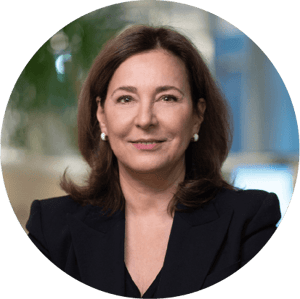A conversation with Carmen Ene and Alisa Mick
Life is what happens to you while you are busy making other plans, goes the saying.
Never has this been truer than for the world’s economy, where for centuries, resources and products have been used and then discarded as waste and replaced, with no concern for their actual potential lifespan or ecological footprint.
Today, according to the Circular Gap Report, only 7% of the world is circular, and this proportion needs to increase significantly if we want to reduce pressure on natural resources, create sustainable growth and achieve the EU’s 2050 climate neutrality target.
A circular economy can also improve the affordability of quality goods that would otherwise be out of reach for many segments of the population, and it can help increase the resilience of supply chains, whose disruption affects vulnerable groups more than others.
So, how can we get there?
Today we had the pleasure to meet with our CEO, Carmen Ene – who recently joined the Circulator 2.0 programme organised by the University of Helsinki as an advisor – and Alisa Mick, programme coordinator and co-founder of The North Mix and MiXi, a non-profit organisation for accelerating the transition towards a circular economy.
Let’s start with you, Alisa; please tell us more about this programme and how you got involved.
Alisa: 
The Circulator pre-incubation program is one of the entrepreneurship programs run by the University of Helsinki. The Circulator is
dedicated to promoting the combination of entrepreneurship and circular economy as a crucial step towards changing the linear economy. It is an eight-week program designed to guide participants from ideas to solutions. The Circulator provides a comprehensive understanding of the circular economy, focusing on several critical areas. Participants will also receive training in entrepreneurial skills such as problem-solving and lean development. With a strong emphasis on ecosystem cooperation, the program has an Advisory Board to support its participants, and we are more than happy to have Carmen as one of the advisors! The Advisory Board plays a crucial role in the program by providing key challenges faced in various sectors and areas and supporting the teams with their knowledge and expertise. The goal is to produce meaningful and sustainable solutions to real-world problems.
The program is a collaboration between the University of Helsinki incubation programs, The Think Company and MiXi, the organisation I have founded focused on the circular economy. One of MiXi’s goals is to support the growth of circular solutions, so it has been great to build the Circulator program along with the program lead, Santeri Tuovila.
That’s fantastic! Carmen, you have advocated for the need to offer businesses practical and efficient solutions to transition to circular management of digital assets. Why did you think joining the accelerator was important?
Carmen: 
If we want organisations to see the advantage of transitioning to a circular economy, we need to make sure our circular services are
easy to adopt, efficient and financially viable. We are asking them to rethink the make-take-waste model they have used for technology for decades; it’s not an easy leap to make, and that’s why offering them a practical and profitable alternative is imperative.
I joined the accelerator because I firmly believe that the circular economy is the economy of the future and that, as a business leader in this field, I could help empower the next generation of entrepreneurs to move forward and contribute to the creation of a more resilient, sustainable, and inclusive world.
To be honest, I was also curious. You stop living when you stop learning, and I look forward to hearing about innovative and creative projects that can help make Finland and the rest of Europe more circular.
A question for both of you: Finland was the first country in the world to prepare a national road map to a circular economy in 2016, but now lags behind the Netherlands, France and Italy. What can Finland do to accelerate the circular transition?
Alisa:
In my opinion, the public sector still largely dominates the circular economy in Finland. While Finland, as a nation, has achieved remarkable accomplishments through organisations like Sitra, becoming a leading player in the circular economy, the transition cannot be accomplished without the involvement of the private sector. The active participation of corporates, startups, and investors is crucial for a successful transition. Although there are some great examples in Finland, such as 3stepIT, they are not sufficient. We need more private sector involvement, solutions, and incentives to support businesses and consumers to change their business models and consumption habits for a successful transition to a circular economy.
In the Nordics, we have a responsibility that we must take more seriously. We are fortunate to have access to clean water, fresh air, excellent education, and innovative technology. Our region has the potential to make a global impact by collaborating, educating, and co-creating with other countries to promote a circular economy globally. However, we can do more in this regard - taking concrete steps and creating a more sustainable future for all.
Carmen:
I always say that when I launched a joint venture with BNP Paribas in 2019, I took 3stepIT out of Finland without taking Finland out of 3stepIT. That’s because we are incredibly proud of our Finnish roots as an organisation, and we believe it’s crucial to keep the Finnish values – love for nature, solidarity, transparency, curiosity, and inclusion, to name a few – alive in everything we do as we grow and expand. Finland was the first country to prepare a national roadmap to a circular economy several years ago, but the story doesn’t end there. If you look at that document, Sitra – the organisation that led the initiative – created a roadmap to support Finland’s transition while also providing tools, guidelines and inspiration for other countries that want to take steps towards a circular economy. That shows that while we might not be the most circular nation in Europe, we are probably already one of the key enablers of circularity for the rest of Europe.
McKinsey said last year that the Nordics could become the next Silicon Valley, a Sustainability Valley. By the same token, I have no doubt that Finland is well-positioned to become the Circular Valley of Europe if the public and private sectors start working together towards that common goal.
We need to ask you an uncomfortable question. You both work in business and technology. According to the Commission’s Women in Digital Scoreboard 2021, women only represent one-third of STEM graduates and 19% of ICT (information and communications technology) specialists. What can we do to narrow the gap? Can transitioning to a circular economy help?
Alisa:
First, it is interesting to point out that research suggests that women tend to prioritise impact-oriented decision-making and consider social and environmental factors more than men. As a result, they are more receptive to the environmental benefits of a circular economy.
In addition, it has been noted that the EU's circular economy has the potential to create two million jobs by 2030. Even if not all these jobs are in the technology sector, many will. Therefore, for a successful transition to a circular economy, women's active participation in the sector is crucial.
Governments, companies, and academic institutions must collaborate and implement initiatives that encourage women's participation in this transition, such as mentorship programs, gender-inclusive hiring practices, and promoting female leadership. A more gender-diverse workforce can bring fresh perspectives and innovative solutions to achieve a circular economy, making it more sustainable and effective.
Carmen:
If we want to shatter the glass ceiling and improve diversity in the tech sector, we must look beyond the numbers and focus on the causes.
Are women less interested in technology than men? I don’t think so. Do they know that after years of studying to become an ICT professional, they will have way fewer career opportunities than their male counterparts? Yes. We need a 360 degrees approach that includes policy changes and commitments from governments and businesses if we want to achieve real change.
Schools and families also have a crucial role to play in educating girls not to be afraid of getting interested in technology – which is still often considered to be a boys’ activity. Supportive parents and teachers can make a big difference.
To answer your second question: the circular economy can absolutely be a tool to achieve greater equality, and it’s not just about democratising access to technology by making it more affordable. Women are disproportionately represented in low-value-added activities linked to recycling and waste management – but what if rather than focusing on handling waste, they could be trained to repair or remarket assets?
Thank you, Carmen and Alisa, for the insightful conversation. One last question: where can our readers see you next?
Carmen:
Besides the Accelerator, I am incredibly excited about having been invited to speak at the World Circular Economy Forum this year. I look forward to the event and meeting like-minded promoters of circularity from across the globe.
Alisa:
Everyone is welcome to register for an event about Investing in Circularity and Sustainability during the World Circular Economy Forum week. The event is organised in collaboration with MiXi Center, Helsinki Partners, the City of Helsinki and Helsinki–Uusimaa Circular Valley.
Another event where you can meet me and Carmen is the final event of the Circulator program on June 9th. It will be open to everyone, and you’ll have the opportunity to meet the Circulator teams!